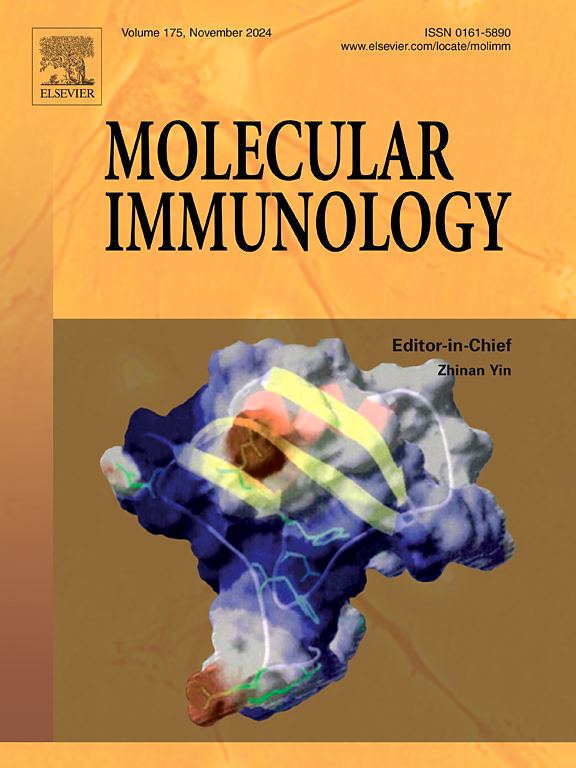PU.1 内含子区对发育中 B 细胞中活化诱导的胞苷脱氨酶基因转录的负调控
IF 3
3区 医学
Q2 BIOCHEMISTRY & MOLECULAR BIOLOGY
引用次数: 0
摘要
激活诱导胞苷脱氨酶(AID,由 Aicda 编码)在生殖中心 B 细胞的体细胞超突变和类开关重组中发挥着关键作用。然而,AID 的脱靶效应与人类白血病和淋巴瘤有关。一个由相关转录因子 PU.1 和 Spi-B 缺失驱动的前体 B 细胞急性淋巴细胞白血病小鼠模型显示,C->T 转换突变与 AID 诱导的相符。因此,我们假设 PU.1 在 B 细胞发育过程中对 Aicda 起负向调节作用。与野生型细胞相比,缺乏 PU.1 和/或 Spi-B 的白血病细胞和骨髓前 B 细胞中 Aicda mRNA 转录水平升高。通过染色质免疫沉淀,发现PU.1与Aicda第一个内含子中的负调控区(R2-1)相互作用。在培养的前B细胞中,CRISPR-Cas9诱导的R2-1突变导致Aicda在脂多糖刺激下上调。在瞬时转染分析和荧光素酶检测中,PU.1相互作用位点和邻近序列的突变导致R2-1的抑制能力降低。这些结果表明,与 PU.1 相互作用的内含子区对发育中的 B 细胞中 Aicda 的转录具有负调控作用。本文章由计算机程序翻译,如有差异,请以英文原文为准。
Negative regulation of activation-induced cytidine deaminase gene transcription in developing B cells by a PU.1-interacting intronic region
Activation-induced cytidine deaminase (AID, encoded by Aicda) plays a key role in somatic hypermutation and class switch recombination in germinal center B cells. However, off-target effects of AID are implicated in human leukemia and lymphoma. A mouse model of precursor B cell acute lymphoblastic leukemia driven by deletion of the related transcription factors PU.1 and Spi-B revealed C->T transition mutations compatible with being induced by AID. Therefore, we hypothesized that PU.1 negatively regulates Aicda during B cell development. Aicda mRNA transcript levels were increased in leukemia cells and bone marrow pre-B cells lacking PU.1 and/or Spi-B, relative to wild type cells. Using chromatin immunoprecipitation, PU.1 was found to interact with a negative regulatory region (R2–1) within the first intron of Aicda. CRISPR-Cas9-induced mutagenesis of R2–1 in cultured pre-B cells resulted in upregulation of Aicda in response to lipopolysaccharide stimulation. Mutation of the PU.1 interaction site and neighboring sequences resulted in reduced repressive ability of R2–1 in transient transfection analysis followed by luciferase assays. These results show that a PU.1-interacting intronic region negatively regulates Aicda transcription in developing B cells.
求助全文
通过发布文献求助,成功后即可免费获取论文全文。
去求助
来源期刊

Molecular immunology
医学-免疫学
CiteScore
6.90
自引率
2.80%
发文量
324
审稿时长
50 days
期刊介绍:
Molecular Immunology publishes original articles, reviews and commentaries on all areas of immunology, with a particular focus on description of cellular, biochemical or genetic mechanisms underlying immunological phenomena. Studies on all model organisms, from invertebrates to humans, are suitable. Examples include, but are not restricted to:
Infection, autoimmunity, transplantation, immunodeficiencies, inflammation and tumor immunology
Mechanisms of induction, regulation and termination of innate and adaptive immunity
Intercellular communication, cooperation and regulation
Intracellular mechanisms of immunity (endocytosis, protein trafficking, pathogen recognition, antigen presentation, etc)
Mechanisms of action of the cells and molecules of the immune system
Structural analysis
Development of the immune system
Comparative immunology and evolution of the immune system
"Omics" studies and bioinformatics
Vaccines, biotechnology and therapeutic manipulation of the immune system (therapeutic antibodies, cytokines, cellular therapies, etc)
Technical developments.
 求助内容:
求助内容: 应助结果提醒方式:
应助结果提醒方式:


